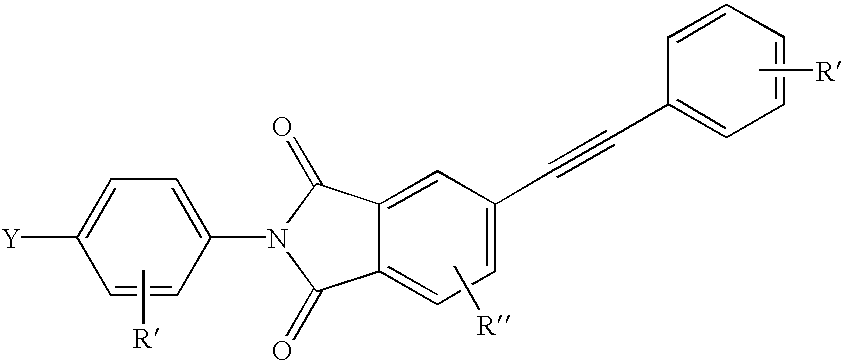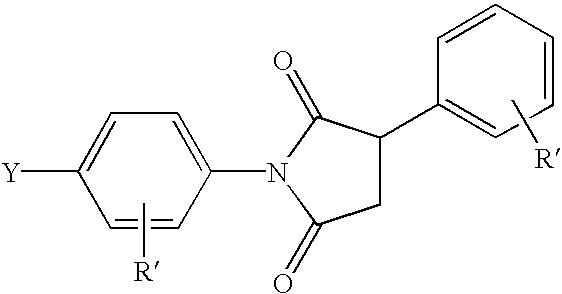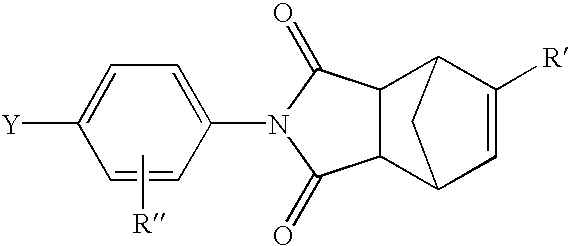Liquid crystalline thermosets from ester, ester-imide, and ester-amide oligomers
- Summary
- Abstract
- Description
- Claims
- Application Information
AI Technical Summary
Benefits of technology
Problems solved by technology
Method used
Image
Examples
example a
Phenylacetylene Terminated Carboxylic Acid; PE-COOH
[0043] Into a 250 mL two-neck round bottom flask equipped with a mechanical stirrer, condenser and a nitrogen gas inlet was placed 4-aminobenzoic acid (8.0 g, 58 mmol), 4-phenylethynylphthalic-anhydride (14.5 g, 58 mmol) and 150 mL glacial acetic acid. This mixture was stirred at 25.degree. C. for 1 hour after which the temperature was raised to reflux for 12 hours. The reaction mixture was cooled to 25.degree. C. and the precipitated product was collected by filtration, washed twice with hot ethanol and dried under vacuum at 100.degree. C. for 8 hours.
example b
Phenylacetylene Terminated Acetoxy Phenol; PE-OAc
[0044] Into a 250 mL two-neck round bottom flask equipped with a mechanical stirrer, condenser and a nitrogen gas inlet was placed 4-aminophenol (6.3 g, 58 mmol), 4-phenylethynylphthalicanhydride (14.5 g, 58 mmol) and 200 mL glacial acetic acid. This mixture was stirred at 25.degree. C. for 1 hour after which the temperature was raised to reflux for 12 hours. The reaction mixture was cooled to 25.degree. C. and the precipitated product was collected by filtration, washed twice with ethanol and dried under vacuum at 50.degree. C. for 8 hours.
[0045] The dried end-cap products were refluxed in 150 mL acetic anhydride for 5 hours. Yellow crystals precipitated upon cooling and were collected by filtration, washed with ethanol and dried under vacuum at 80.degree. C. for 8 hours.
[0046] Other end groups were made using similar procedures. The yields and thermal analysis results (differential scanning calorimetry) of all compounds are summariz...
example 1
[0047] A 100 mL 3-neck round bottom flask was charged with 4-acetoxybenzoic acid (45.1 g, 0.25 mol), 6-acetoxy-2-naphtoic acid (38.4 g, 0.17 mol), PE-COOH (2.43 g, 6.6 mmol), PE-OAc (2.52 g, 6.6 mmol) and 4 mg potassium acetate. The flask was equipped with a sealed glass paddle stirrer, a nitrogen inlet tube and an insulated distillation head. The flask was purged with nitrogen gas, and the reaction mixture was heated over a 3 hour period on a woods metal bath, under a slow stream of nitrogen, with the reaction temperature being increased from 150.degree. C. to 300.degree. C. At this point the temperature was increased to 310.degree. C. over 30 minutes and a vacuum was slowly applied for 25 min. The opaque melt was cooled to room temperature and the product (6HBA / 4HNA-9PE) was broken from the flask and ground into a fine powder.
PUM
| Property | Measurement | Unit |
|---|---|---|
| Angle | aaaaa | aaaaa |
| Melt viscosity | aaaaa | aaaaa |
| Molar mass | aaaaa | aaaaa |
Abstract
Description
Claims
Application Information
 Login to View More
Login to View More - R&D
- Intellectual Property
- Life Sciences
- Materials
- Tech Scout
- Unparalleled Data Quality
- Higher Quality Content
- 60% Fewer Hallucinations
Browse by: Latest US Patents, China's latest patents, Technical Efficacy Thesaurus, Application Domain, Technology Topic, Popular Technical Reports.
© 2025 PatSnap. All rights reserved.Legal|Privacy policy|Modern Slavery Act Transparency Statement|Sitemap|About US| Contact US: help@patsnap.com



